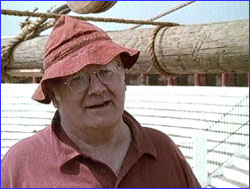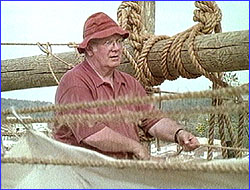
|
 |
 |
Owain Roberts, Nautical Archaeologist NOVA: What is your everyday work like, when you're not called off to Egypt to help raise an obelisk? ROBERTS: I'm concerned with reconstructions from the remains of vessels. For example, a few months ago I worked on a fourth century a.d. Celtic boat, where I reconstructed the remains and produced what might have been a viable ship—on paper of course. I've also nearly finished work on a Bronze Age boat that was found in Dover. The work has been going on for seven years now. I've done all the reconstruction work and drawings and all the technical calculations necessary for finding out how she might perform. This is what I do with most of the boats I work on. NOVA: Have you had any previous experience on a project like the obelisk-raising attempt? ROBERTS: I was involved in the NOVA Colosseum project. Because of my background I had knowledge of rigs, both medieval and classical, so I was able to interpret Rainer Graefe's theories about how these covers might have been drawn out over the colosseum and over the amphitheater we used in Spain. I was also involved in the practical side of making all the ropes the right lengths and splicing all the blocks together and everything else. NOVA: How important do you think your skills are to the outcome of this new attempt to raise the obelisk? ROBERTS: My son will do the rigging. (I shall, no doubt, look over his shoulder.) My problem is to get one of the small stones, the two-tonners, aboard a 23-foot boat that's been built in Alexandria for this project. I've also made two models of the Hatshepsut barge, [a hieroglyphic relief by the pharaoh Hatshepsut that shows two obelisks on a barge] and I've got a method to demonstrate of loading up the barges with the obelisk.
NOVA: What's your sense of how this attempt will be different from the last one? ROBERTS: I think there's much more of a determination to solve the problems before we get there, and I think it could well be successful. NOVA: What do you expect to learn from this experience? ROBERTS: Oh, I've learnt it all by now, by studying the darn drawings and making these models and things! NOVA: But isn't it a little bit different when you get out there and actually have to work with the real physical objects? ROBERTS: Absolutely. I'm concerned that the 23-foot boat will behave as I hope it will behave. The two model boats with which I'll demonstrate moving large obelisks like Hatshepsut did—I think that will probably work pretty well. It's a bit of a surprise, but I've tried it out here, in the bath, anyway. I made these models to an absolute scale, so all the weights and the sizes are as they should be. But I should be able to figure out a method that works. I think so, anyway. NOVA: How impressive do you think it is that the ancient Egyptians pulled this thing off? ROBERTS: Incredible, absolutely incredible. When you think—there's a large obelisk that's broken, the thousand-tonner—when you think they were happily going to shift that down to the edge of the Nile and load it aboard a ship and move it—they were not phased by anything like that, were they? They were extremely good civil engineers. They also knew their ships remarkably well, because they knew about stability, they knew about loading, they knew hydraulics, which is what it boils down to. They maybe didn't have it out in numbers but they could do sufficient calculation, enough to make things work. And they clearly were working, because they would have never lifted a thousand-tonner without having all that knowledge as a backup to trying it.  NOVA: Do you think that the method you're going to try
was the method they used?
NOVA: Do you think that the method you're going to try
was the method they used?ROBERTS: I think it is, actually. I've been looking a lot at the Hatshepsut drawings of the barge, and there are more than enough clues in that to suggest that it was not a single barge but rather two barges side by side. You know, the Egyptians had problems with perspective, and I think we've got a perspective problem here, which is explained by some of the detail as being on a second barge, behind. If you propped two smaller barges about 100 feet long side by side, you can put two obelisks across them, and you've got stability, and you're able to shift them. I want to show that and prove it. It's a fairly original idea, but not totally. Pliny writes about a method in which they used a double barge like this. He's talking 1,500 years later, and I reckon that techniques didn't change all that fast. NOVA: If it works, don't fix it then? ROBERTS: Exactly. It also tells us how the Egyptians understood they could lift large weights like this without the need for cranes, tackle, and all that sort of thing. So I hope I'm going to improve on that - that's the intention. NOVA: If you were a betting man, what odds would you give this project of succeeding? ROBERTS: Pretty good. There's a lot of very careful thought gone into this one, and certainly what I've seen Mark and Henry producing down in London there, they certainly have been scratching their heads and getting proper ideas, doing all the calculating work on it. Hopefully what I'm going to do will also perhaps produce a new method for shifting very large obelisks without capsizing vessels. I'm pushing the boundaries. It'll be interesting to see how that works. Explore Ancient Egypt | Raising the Obelisk | Meet the Team Dispatches | Pyramids | E-Mail | Resources Classroom Resources | Site Map | Mysteries of the Nile Home Editor's Picks | Previous Sites | Join Us/E-mail | TV/Web Schedule About NOVA | Teachers | Site Map | Shop | Jobs | Search | To print PBS Online | NOVA Online | WGBH © | Updated November 2000 |
 Owain Roberts (L)
Owain Roberts (L) Roberts' skill with ropes and nautical engineering
brought success to a NOVA project in which a roof was
raised over a small colosseum.
Roberts' skill with ropes and nautical engineering
brought success to a NOVA project in which a roof was
raised over a small colosseum.